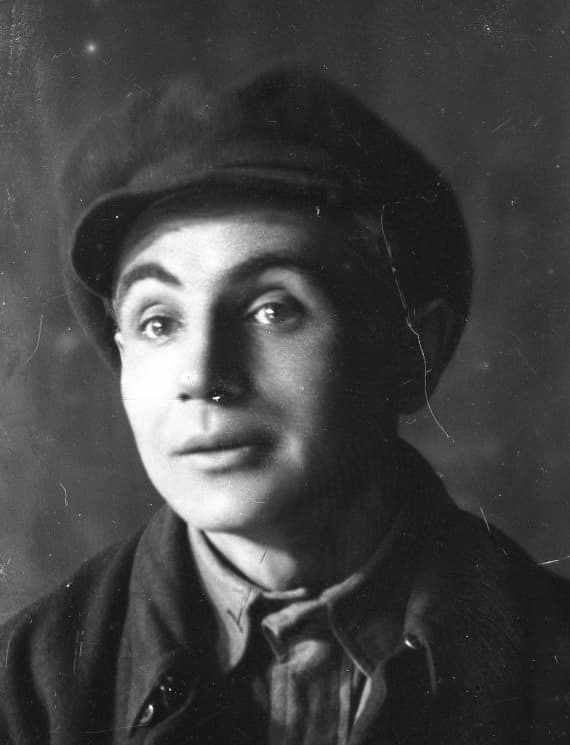Tragedy in 3 acts by Oleksandr Korniichuk
Premiere: November 29, 1933
Director: Borys Tiahno
New Version: Les Dubovyk
Artist: Vadym Meller
Music: Yulii Meitus
(Director – V. Ya. Voronov; Conductor – B. Kryzhanivskyi, Member of Director’s Lab – Ya. I. Brestovytskyi, Dances – Ye. D. Vihiliov, Stage Director – M. Stepanko, Lighting – F. Pozniakov, Costumes – E. Kolenko, Props – P. Kramich, Machinist – M. Brusov)
Cast
Members of the Bolshevik Committee of the Black Sea Squadron:
Haidai – Amvrosii Buchma (honored artist of the Ukrainian SSR), Danylo Antonovych, Oleksandr Khvylia
Stryzhen – Ivan Marianenko (honored artist of the Ukrainian SSR), Mytrofan Kononenko
Oksana – Nataliia Uzhvii, Sofiia Fedortseva, Vashchenko
Commissar – Danylo Antonovych, Rostyslav Ivytskyi
Bukhta, Boatswain – Yosyp Hirniak, Marian Krushelnytskyi (honored artist of the Ukrainian SSR), Serhii Khodkevych
Frigate, Fireman – Yevhen Bondarenko
Palada – Andrii Makarenko
Baltic Man, Representative of the Center – Oleksandr Khvylia
Admiral – Mykhailo Zhadanivskyi, Fedir Radchuk
Captain of the Flagship – Andrii Makarenko, Mykola Savchenko
Kobza, Boatswain – Les Serdiuk, Hryhorii Kozachenko
Knoris – Fedir Radchuk, Dmytro Ponomarenko
Korn – Vasyl Stetsenko
Officers: Roman Cherkashyn, V. Voronov, S. Verkhatskyi, P. Olkhovskyi, Dmytro Ponomarenko, B. Zybtsev,
Nahar, Chairman of the Delegates Meeting – Rostyslav Ivytskyi, Mykhailo Pokotylo
Colonel, Representative of the Central Rada – Hryhorii Kozachenko
Yunga – Mykola Nazarchuk, Ye. Yeshchenko, Ye. M., S. Lor
Frontline Soldier – Ivan Havryshko
Representatives of:
Destroyer Kerch – V. Sokil
Destroyer Pylkiy – I. Kostiuchenko
Destroyer Stremitelny – O. Nemzer
Battleship Volia, Boatswain – Demyd Babenko
Battleship Svobodnaya Rossiia, Boatswain – M. Pishvaniv
Underwater Group, Boatswain – L. Rstkian
Destroyer Derzkiy – L. Myroshnychenko
Destroyer Zvonkiy, Boatswain – Yo. Pavlovskyi
Destroyer Strogy – M. Kirin
Destroyer Zorkiy – P. Kravchenko
Aliosha – S. Verkhatskyi
Vasia – Dmytro Ponomarenko, B. Zybtsev
Guard – P. Olkhovskyi, N. Kuritsyn
Sailors: Ya. Brestovytskyi, Yo. Pavlovskyi, M. Pishvaniv, P. Kravchenko, L. Myroshnychenko, B. Zybtsev,
N. Mendelikhes, I. Mohylevskyi, L. Kryvokobylskyi, M. Kirin, I. Klymchuk, H. Volokhonenko, N. Kuritsyn,
B. Zotov, V. Hryhorov, Mykola Savchenko
Director Borys Tiahno received from playwright Oleksandr Korniichuk the finished text of the play Death of the Squadron in August 1933. The play was then read and discussed by the directing staff, who recommended that it be added to the repertoire. Les Kurbas read the play and officially invited Borys Tiahno to direct it. Later, composer Yulii Meitus and artist Vadym Meller joined the production. The artists decided to realistically recreate the figurative vocabulary of the play. Borys Tiahno even informed the public on the pages of Literaturna Hazeta (Literary Newspaper) in October 1933 of his directorial plans to make a true reproduction of the dramaturgical images, noting the play’s stageability and its ideological power.
Berezil’s leading actors starred in the play: Amvrosii Buchma, Yosyp Hirniak, Nataliia Uzhvii, Ivan Marianenko, Dmytro Miliutenko, and others. Obviously, in the early 1930s, the performance aesthetics in Kurbas’s theater rested largely on the realism and psychologism of the protagonists. This vector was related, in particular, with Kurbas’s “expressive realism,” that was first publicly declared in 1928. With the change in the theater’s aesthetic guidelines came a transformation in the style of acting in Berezil. The metamorphosis in the manner of performance by the artists could be seen in the deviation from the principle of mask images, truthful reproduction of characters, and emphasis on the individual traits of the characters. The concept behind many of Berezil’s productions, including Death of the Squadron, followed this line.
The play was based on real events that took place in 1918. On Lenin’s orders, the sailors were supposed to sink the Black Sea Fleet Squadron so that it wouldn’t be transferred to the Ukrainian state. This became a test for many sailors, who didn’t understand why this should be done for the sake of the policy of the Soviet authorities. Accordingly, the characters in the play were split into positive and negative ones. The playwright traveled to Sevastopol to meet with witnesses of these legendary events. An old boatswain who told the story about the sinking of the last ship was the inspiration for boatswain Bukhta – the last role played by Yosyp Hirniak at the Berezil (the actor would soon be arrested and sent to the northern settlement of Chibyu). Mention of his participation in this play was removed from all sources. The boatswain that Korniichuk modeled after someone he knew came out very soft and warm-hearted in the performance. The photo of Hirniak playing Bukhta – a short, elderly man with a round beard and faint smile – conveys the sailor’s cheery emotional state and optimistic attitude to life’s troubles. In the final chord of Hirniak’s symphony with Berezil, the actor once again managed to create a complete image that became etched in the memory of contemporaries for a long time. Recalling Hirniak’s Bukhta, Yurii Dyvnych said: “This was Hirniak’s last positive (in the direct sense of the word) image of a person in Berezil. Hirniak put all the depth and warmth of his soul into this image of a positive Ukrainian person”
Zoria Sydorenko, who wrote a monograph about Borys Tiahno, notes that the interpretation of negative characters (boatswain Kobza and admiral Hranat) by actors Oles Serdiuk and Dmytro Miliutenko was psychologically convincing. “The enemy camp was contrasted with exceptionally heroic positive images of devoted fighters for the socialist revolution performed by I. O. Marianenko (Stryzhen) and N. M. Uzhvii (Oksana), A. M. Buchma (Haidai), and others”
The play was a success with the audience and its pathos resonated with the loud propaganda of the Soviet system. Obviously, artistically the production was professional done – with monumental paintings and an epic panorama of sunken ships in the background. The finale of the tragedy moved the audience, as the sailors of the last ship of the Black Sea Squadron walked heroically and passionately straight through the hall.

